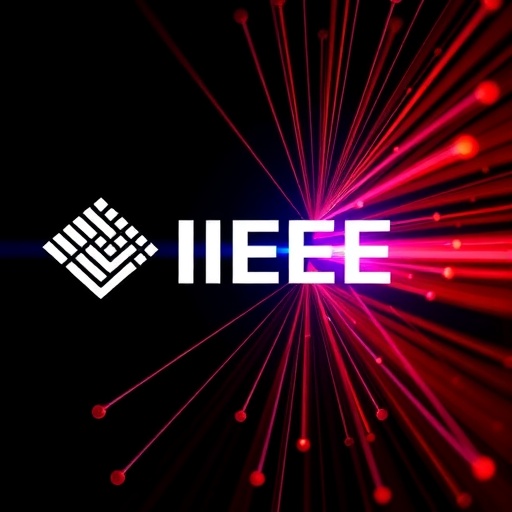In a groundbreaking development in the field of photonics, a team of international researchers has penned a comprehensive review advancing our understanding of electron-photon interactions in the context of electron microscopy. This study, highlighted by its focus on the remarkable coupling of free electrons with nonlinear optical states, promises to open up new avenues in both electron microscopy and integrated photonics. The researchers, led by Dr. Yujia Yang and Professor Tobias J. Kippenberg from the Swiss Federal Institute of Technology Lausanne (EPFL), alongside Professor Claus Ropers from the Max Planck Institute for Multidisciplinary Sciences in Germany, synthesized groundbreaking findings that could redefine our technological landscape.
The research is set against the backdrop of nonlinear optical dynamics, where light exhibits intensity-dependent responses when interacting with materials under high-intensity sources. This phenomenon plays a pivotal role in modern photonics applications, which extend from the realm of lasers and amplifiers to the intricate technologies used for sensors, quantum optics, and the complex dynamics of light-matter interactions. These nonlinear effects are not merely theoretical concepts; they are integrated into practical devices, particularly the microresonator-based optical frequency combs, also known as microcombs. These compact, chip-integrated systems produce a spectrum of equidistant lines using a monochromatic laser, generating significant implications for areas like frequency metrology and signal processing.
The team’s recent advancements build upon a robust foundation of research into the manipulation of free electron beams via light within electron microscopy. Achieving an unprecedented level of control over the interactions between electrons and light, the researchers are paving the way for next-generation electron microscopy techniques that promise to enhance resolution and measurement precision. Such innovations may facilitate advanced electron spectroscopy, coherent modulation, and the development of novel electron-driven light sources. By leveraging advanced photonic structures, the researchers demonstrated how free electrons can effectively interact with light, particularly through the use of nanostructured metallic interfaces and plasmonic nanoparticles that enable electron-photon interactions via surface plasmon polaritons.
However, despite these notable advancements, prior studies predominantly focused on the linear dynamics of high-quality factor (Q) microresonators. This lack of consideration for the nonlinear optical dynamics presents an exciting opportunity, as the new review highlights. It meticulously summarizes how these nonlinear effects can be harnessed to revolutionize electron microscopy, particularly emphasizing breakthroughs achieved in 2024. Among the key findings presented is the coupling of free-electron beams within a transmission electron microscope with various spatiotemporal optical waveforms associated with coherent or incoherent microcombs generated by optical parametric oscillations.
Dr. Yang elaborated on the significance of these advances: “Our experimentation not only demonstrated the coupling of free electrons with diverse optical waveforms but also spotlighted the potential of ultrafast electron-beam modulation through the utilization of chip-based femtosecond temporal solitons. This novel approach marks a substantial leap forward in our ability to manipulate electrons dynamically.” The implications of this research extend far beyond traditional microscopy applications, as they hint at a future where electronic beams and light can be finely tuned to achieve unprecedented levels of control and measurement.
In addition to these innovative coupling techniques, the review encompasses a range of other notable advancements made in 2024. For instance, the concept of attosecond electron microscopy through free electron homodyne detection is explored, which could fundamentally alter the way we observe electronic motion on ultra-short time scales. Moreover, the probing of polariton wave packets with free electron resonant interferometry is positioned as a promising avenue for investigating material properties at the quantum level. The generation and analysis of chiral electron coils represent another fascinating intersection of optics and electron dynamics, opening doors to future research avenues in chiral optics and materials science.
As emphasized by Professor Kippenberg, the researchers view these developments as the dawn of a new era in photonics technology. “The richness of nonlinear optical dynamics within high-Q microresonators not only presents exciting opportunities for controlling free electrons through nonlinear optics but also allows for the use of electron beams as novel probes in nonlinear optical phenomena,” said Kippenberg, highlighting the dual aspects of these interactions.
Expectations are high, as Professor Ropers adds, “We anticipate that these groundbreaking advancements will provide fertile ground for innovative research directions and applications across various domains, including state-of-the-art electron imaging techniques and advanced spectroscopy methods.” The excitement surrounding these findings is palpable, positioning this work as an important milestone that will likely propel the field of electron photonics into uncharted territories.
As researchers continue to push the boundaries of what is possible with electron-photon interactions, the implications are vast. The upcoming studies are expected to generate momentum in the development of sophisticated electron control techniques, which could enhance laser-based particle accelerators and lead to breakthroughs in ultrafast quantum optics. The excitement generated by these advancements is likely to resonate widely within the scientific community, hinting at innovations that could eventually translate into real-world applications—ranging from telecommunications to the development of next-generation imaging systems.
In sum, the synthesis of electron-photon interactions detailed in this recent review not only sheds light on the fundamental physics governing these systems but also establishes a roadmap for future explorations. As advances in nonlinear integrated photonics and electron microscopy continue to evolve, we can only imagine the transformative impact they will have across multiple scientific disciplines and technological applications.
Subject of Research: Electron-photon interactions in electron microscopy
Article Title: Photonics Breakthroughs 2024: Free-Electron Interaction with Nonlinear Optical States
News Publication Date: 2-Sep-2025
Web References:
References: Yujia Yang et al. DOI: 10.1109/JPHOT.2025.3604853
Image Credits: Ryan Allen / Second Bay Studios
Keywords: Applied sciences and engineering, Applied physics, Applied optics, Photonics, Physics, Optics, Mechanics, Quantum mechanics, Nanotechnology, Materials science, Electrical engineering, Electronics, Microscopy, Laser systems.




